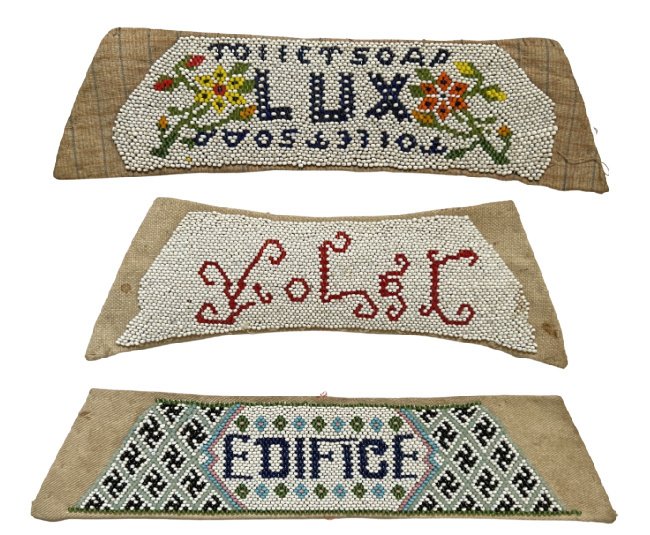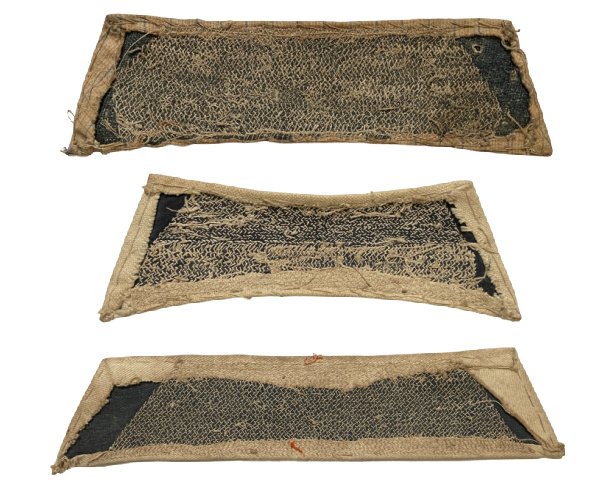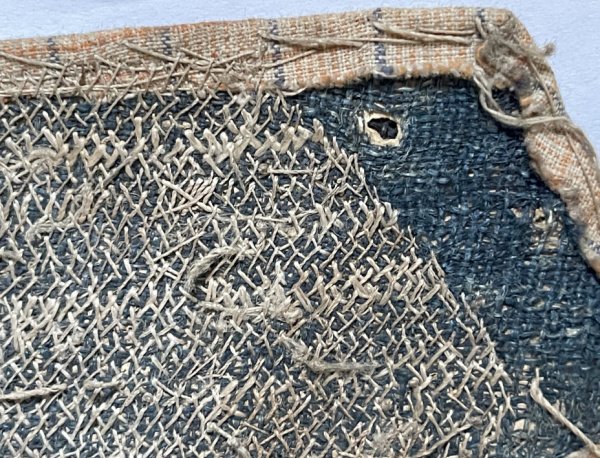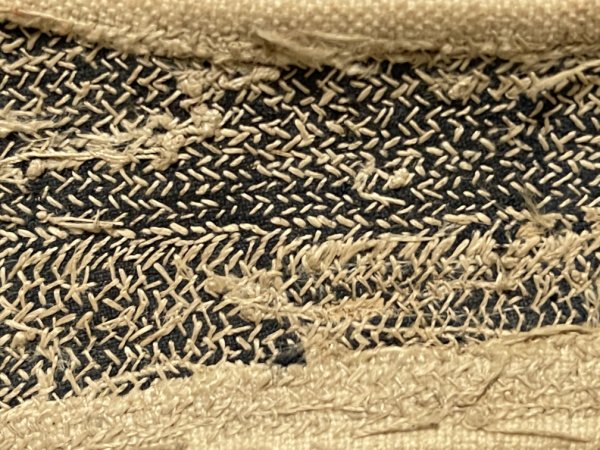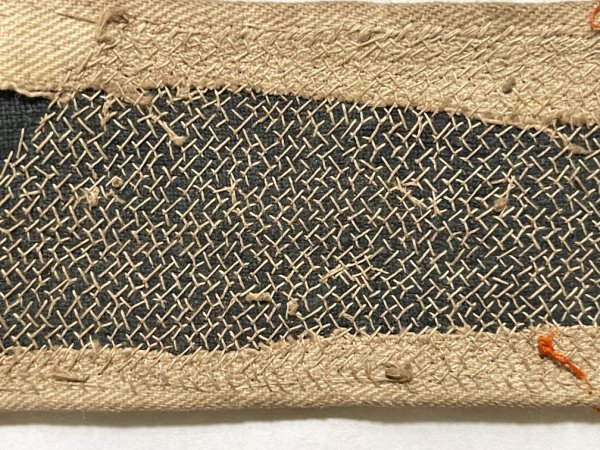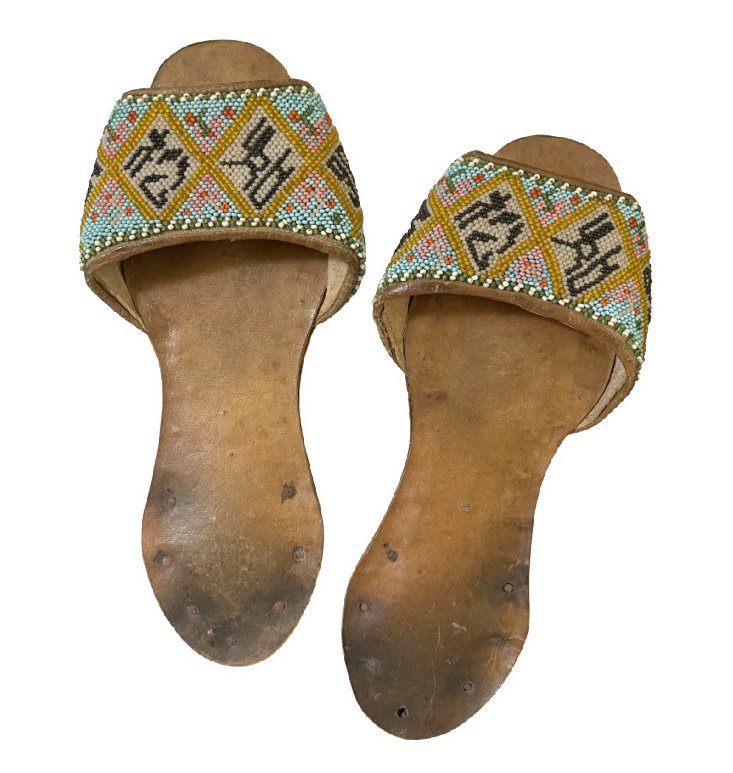chinese beaded slipper panels Inscribed with Western Motifs
In Chna, during the Republic of China period (1912-1949), a great deal of beadwork was made. Some are still offered for sale in curio shops or flea markets in Beijing, Hong Kong and elsewhere. Others may turn up on Ebay.
The pieces shown above represent a functional, everyday genre: beaded slipper or sandal panels, made to be worn on domestic feet, in other words, not made for export. Unlike most comparable panels, which bear inscriptions in Chinese characters or simple motifs from the natural world - flowers, butterflies, birds - the three panels shown above carry Western consumer brand logos as they looked in the ca. 1920s-40s, when Western commodities were marketed in treaty port cities such as Shanghai, Canton (Guangzhou), Xiamen, Ningbo and Fuzhou. Glass seed beads were a Western commodity too, imported from Europe. That Chinese beaders apparently adopted them quickly suggests prior experience in bead embroidery - with Chinese glass beads, seed pearls or coral. The cloth to which the beads are sewn, on the other hand, is often, for the most part, Chinese-made, possible even homemade.
At first glance, the three panels look like straightforward attempts to reproduce foreign logos. But I believe something deeper was also at work: the Chinese love of the written word, in any language, it seems - and the cultivation of literacy as an end in itself. When these slipper panels were made, literacy was not yet universal in China. It’s even possible that the beaders who produced these panels - probably young women - were illiterate. Maybe their supervisor was illiterate, too. However, someone they knew was trying to create a niche in the domestic women’s-wear market for slippers with exotic writing.
Did foreign motifs catch on as a trend? It’s hard to say. Perhaps not, since beaded slipper panels with native Chinese motifs and inscriptions survive in far greater numbers, not just on the slipper panels but on the beaded headbands, tobacco bags and other small pieces made in quantity too.
“Lux Soap” is so common a brand that it needs no explanation (for people of my generation!). How carefully the beader situated the white dots on the blue letters of “Lux.” She may have been beading over an outline inked onto a panel of canvas. Such an outline would certainly have made it easier for her to bead the words “Toilet Soap” both right-side up and upside down.
“Violet” is not a familiar brand name now, but it was once a kind of face powder that came in a colorful metal tin (reference coming soon). Great efforts were expended while making the slipper panel to reproduce the brand’s italic script accurately in beads.
“Edifice” is harder to trace. A brand of watch, maybe? Or something else? I have more research to do. Here again, one senses the beaders (or her supervisor’s) desire for accurate reproduction, a token true to its type.
The backsides of these panels are also interesting for the stories the stitches can tell, the ways they reflect the beader’s abilities, mood, or dispostion toward her work. While some of the stitches form meticulous x-shapes, others look a bit sloppy. The way these panels were beaded - attaching one bead at a time - is one of the slowest methods every invented. I gave it up years ago after my very first try. Filling one square inch took an 8-hour day. At that rate, each of these panels must have taken days to make. Plus, each had to be made as one of a pair - and pairs had to match!
The good thing about such a dense beading technique is this: it creates a durable surface akin to armor, which protects the layers of cloth below, increasing their durability - an important quality for foot gear. The two pairs of slippers (or sandals or mules) below show signs of heavy use. While the pair on the left looks rather crudely made, with thick, irregular iron nails holding the layers of leather together, the pair on the right seems finer. It makes sense that there were degrees of quality and cost within this genre - and designs for a wide range of tastes.
The pair at left conveys wishes for good luck in both English and Chinese amid a simple, diagonal grid. The pair at the right prefers stylized Chinese characters between small floral motifs.
Both pairs seem equally loved - and equally worn.


